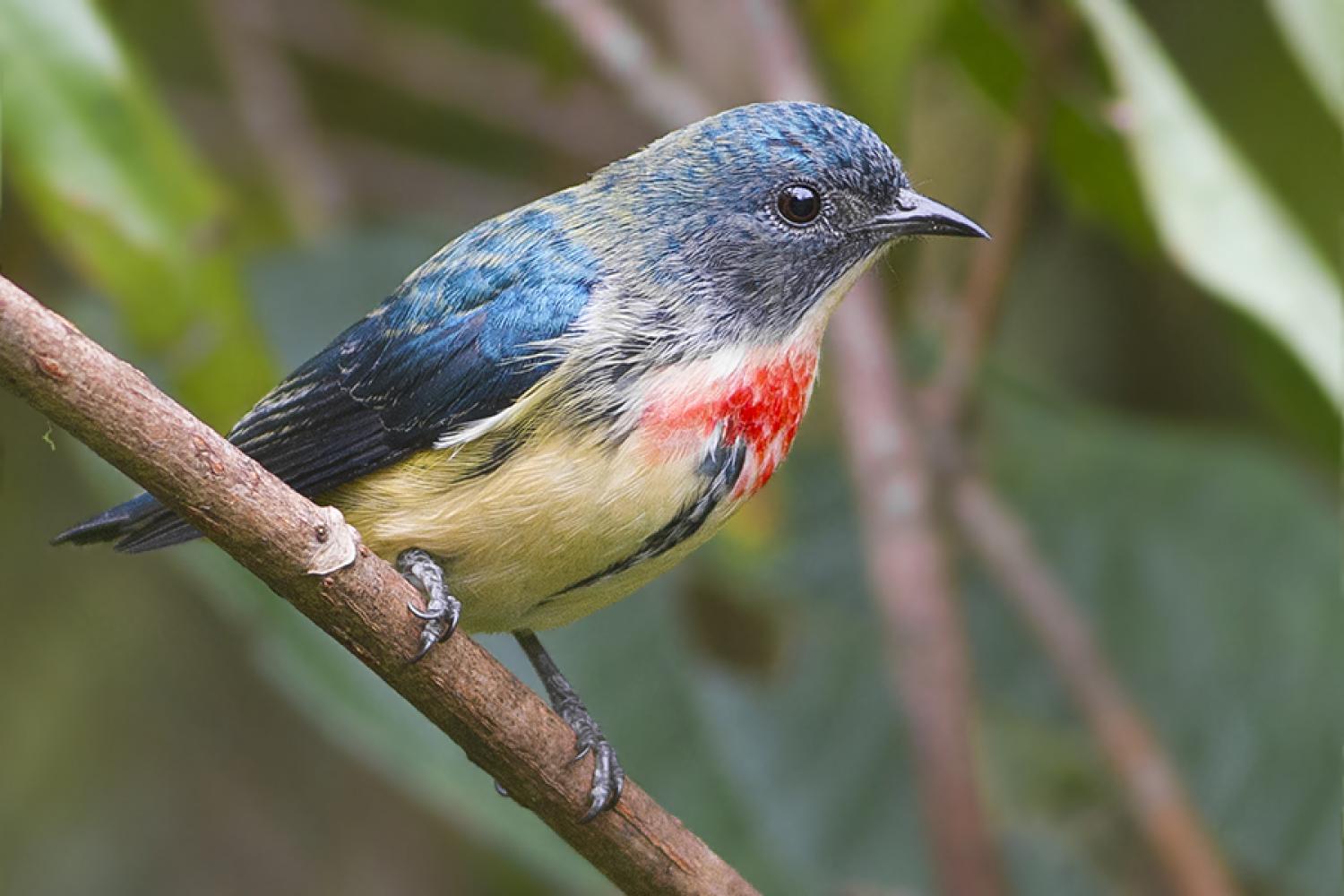Species of Thailand
Fire-breasted flowerpecker
Dicaeum ignipectus
Edward Blyth, 1843
In Thai: นกกาฝากอกเพลิง
The fire-breasted flowerpecker (Dicaeum ignipectus) is a species of bird in the family Dicaeidae found in the Indian Subcontinent and Southeast Asia. Like other flowerpeckers, this tiny bird feeds on fruits and plays an important role in the dispersal of fruiting plants. Unlike many other species in the genus, this species has marked sexual dimorphism with the male having contrasting upper and lower parts with a distinctive bright orange breast patch. The female is dull coloured.
Description
The fire-breasted flowerpecker is a small flowerpecker with a small and dark bill. The male has glossy blue-black upperparts. The underside is buffy but a bright red breast patch. Starting below it and along the middle is a short black stripe going down till the belly. The female is dark olive above and buff below. The sides are olive and the bill has a pale base.
Weighing just 7 - 9 g and measuring under 7 cm long, it is one of the smallest flowerpeckers. They are usually found at the tops of the trees especially on mistletoes. They have a shrill call given regularly and has been likened to snipping scissors and a staccato tsit.
The species was first described by Edward Blyth in 1843 based on a specimen obtained from Nepal by B H Hodgson. The name was based on Hodgson's manuscripts but was published by Blyth. The type specimen claimed to have been deposited at the British Museum is said to be lost, but may exist in the collection of the Asiatic Society museum in Calcutta.
It has been said to be "the smallest bird of India" or "perhaps the smallest":
Distribution
It is found widely distributed along the sub-Himalayan region in India, Nepal, Bhutan, Bangladesh and extends into Southeast Asia into Indonesia, Laos, Thailand, Vietnam, Taiwan, Malaysia and the Philippines. Its natural habitats are temperate forest, subtropical or tropical moist lowland forest, and subtropical or tropical moist montane forest.
Several populations have been named as subspecies. The nominate ignipectus found along the Himalayas into Southeast Asia on the mainland. The remaining are insular populations and include formosum of Taiwan, luzoniense of Luzon, bonga of Samar and apo of the Negros and Mindanao. The species itself forms a superspecies complex with Dicaeum monticolum, D. celebicum, D. sanguinolentum and D. hirundinaceum which are sometimes all treated as one species. Hybridization with Dicaeum cruentatum has been suggested. Many island forms show patterns of very restricted ranges or micro-endemism and it has been suggested that these be treated with care for conservation planning.
The populations found in the Philippines have males with the underparts similar to D. monticolum while the females have a steel-green gloss on the upperparts unlike the dull green of more northern forms. The Sumatran population beccarii is the most distinct form and differs also from D. sanguinolentum. The males have a steel-green gloss on the upper parts and lack the throat patch while the females have greenish upperparts and lack the red rump.
Throughout its range, the species is found in high mountains above 1000 metres but in China, they may be found during winter at lower altitudes.
Behaviour and ecology
Like many other flowerpeckers, they disperse the seeds of mistletoes. In the Nepal Himalayas, they have been found to be important dispersers of Scurrula species.
In Nainital they are said to breed in June and July. The nest is pendant and purse like, opening on the side towards the top. The nest is thin and felt-like, made up of the hairy coverings of stems from mistletoes. The nest is lined with moss and soft grass. Two or three eggs are laid and both sexes incubate and take care of the young.
In Hong Kong, their population is believed to have increased with maturation of restored forest. They were first recorded in 1954 but have starter breed regularly since 1975.
This article uses material from Wikipedia released under the Creative Commons Attribution-Share-Alike Licence 3.0. Eventual photos shown in this page may or may not be from Wikipedia, please see the license details for photos in photo by-lines.
Category / Seasonal Status
BCST Category: Recorded in an apparently wild state within the last 50 years
BCST Seasonal status: Resident or presumed resident
Scientific classification
- Kingdom
- Animalia
- Phylum
- Chordata
- Class
- Aves
- Order
- Passeriformes
- Family
- Dicaeidae
- Genus
- Dicaeum
- Species
- Dicaeum ignipectus
Common names
- Thai: นกกาฝากอกเพลิง
Synonyms
- Micrura ignipectus
- Myzanthe ignipectus
Conservation status

Least Concern (IUCN3.1)
Photos
Please help us review the bird photos if wrong ones are used. We can be reached via our contact us page.
Range Map

- Chae Son National Park
- Chiang Dao Wildlife Sanctuary
- Chiang Khong District, Chiang Rai
- Doi Inthanon National Park
- Doi Lang
- Doi Pha Hom Pok National Park
- Doi Phu Kha National Park
- Doi Saket District, Chiang Mai
- Doi Suthep - Pui National Park
- Hala-Bala Wildlife Sanctuary
- Huai Nam Dang National Park
- Kaeng Krachan National Park
- Khao Khitchakut National Park
- Khao Soi Dao Wildlife Sanctuary
- Khao Yai National Park
- Khon San District, Chaiyaphum
- Khun Chae National Park
- Mae Fa Luang District, Chiang Rai
- Mae Wong National Park
- Mueang Chiang Mai District, Chiang Mai
- Mueang Nakhon Nayok District, Nakhon Nayok
- Nam Nao National Park
- Pang Sida National Park
- Pha Daeng National Park
- Phu Chi Fa Forest Park
- Phu Hin Rong Kla National Park
- Phu Luang Wildlife Sanctuary
- Phu Suan Sai National Park
- Sakaerat Environmental Research Station
- Taksin Maharat National Park
- Umphang Wildlife Sanctuary



